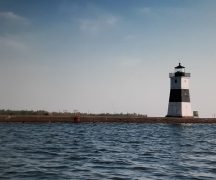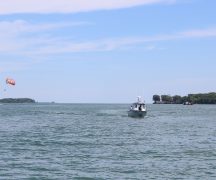By DAVID DUPONT
BG Independent News
The harmful algal bloom in Lake Erie is expected to be moderate this summer.
Scientists studying the problem issued their annual forecast determining the bloom, based on its mass and spread would be a level 4.3 of severity. Anything over 5 is considered a more severe bloom. The highest figure ever recorded was 10.5 in 2015.
Last year’s bloom was 7.3.
And while the actual bloom could turn out to be more severe, conditions for that do not seem to be lining up.
“I will say most of the lake will be fine most of the time,” said Richard Stumpf, a NOAA scientist. The bloom will be mostly in Erie’s western basin.
The forecast announcement was held virtually this year because of the coronavirus pandemic.
Researchers, however, are still not able to predict how toxic a bloom will be. The advice remains: If there’s scum in the water, people and pets should stay away.
Tim Davis, of Bowling Green State University, said efforts were ongoing to get a tool to forecast toxicity. “We’re working on it. … For now, we don’t have that tool.”
While the attention has been on phosphorus’ role in the growth of bloom. The interaction of nitrogen with the phosphorus plays a role in development of toxicity, Davis said.
The blooms are fed by phosphorus run off from the Maumee River watershed.
Laura Johnson, of Heidelberg University, said that the amount of phosphorus that makes its way into the lake is determined in large part by the amount of water that flows through the system carrying that nutrient.
After a spate of wet weather in March, conditions were dry until heavy rain fall at the end of May. Since then conditions have been mostly dry, and that’s expected to continue into August, she said, adding “sorry farmers.”
The result is 325 metric tons of available phosphorus flowing from the Maumee in Lake Erie. That’s a “fairly moderate” amount, but still exceeds the target of 240 metric tons.
The amount exceeded the average loads from 2002-2018. While there are years, Johnson said, where phosphorus loads are higher or lower than expectations, “there are no detachable downward trends.
Johnson said the phosphorus could be coming because of poor fields conditions after last year’s disastrous planting season, as well as phosphorus left in the ground from previous years, so-called “legacy” phosphorus.
Johnson noted that the heavy flows that used to occur every 10 years or so, have been exceeded four times in the last decade. That has contributed to increasing flow of phosphorus.
Chris Winslow, director of Ohio Sea Grant and Stone Laboratory, which usually hosts the event, said “in my experience working with a lot of producers there is uptick in using best management practices.”
Given the size of the Maumee Watershed there is significant lag time before the impact of those practices are seen.
Wood County farmer Kris Swartz, of the Wood Soil and Water Conservation District, spoke of the importance of the state’s H2Ohio program, which was rolled out last year.
Given the thin margins farmers operate on such financial support is essential.
A practice, such as injecting phosphorus into the soil rather than applying on top where it is more likely to run off, is costly. “If we expect farmers to take a risk and invest in a lot of capital purchases, that’s not likely to happen without a program like H2Ohio,” he said.
He’s seen an increase in enthusiasm for water and nutrient conservation programs with some counties with half the farmers enrolled, instead of 2 or 3 percent.
Already Swartz said he’s fielding questions about year two funding from the program.
That participation is important, he said. “We need practices on a wide acreage.”





